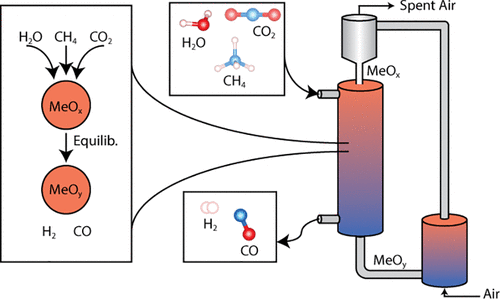当前位置:
X-MOL 学术
›
Ind. Eng. Chem. Res.
›
论文详情
Our official English website, www.x-mol.net, welcomes your
feedback! (Note: you will need to create a separate account there.)
Design and Operations of a 15 kWth Subpilot Unit for the Methane-to-Syngas Chemical Looping Process with CO2 Utilization
Industrial & Engineering Chemistry Research ( IF 3.8 ) Pub Date : 2020-01-16 , DOI: 10.1021/acs.iecr.9b05577 Cody Park 1 , Tien-Lin Hsieh 1 , Yaswanth Pottimurthy 1 , Vedant Shah 1 , Dikai Xu 1 , Yu-Yen Chen 1 , Liang-Shih Fan 1 , Andrew Tong 1
Industrial & Engineering Chemistry Research ( IF 3.8 ) Pub Date : 2020-01-16 , DOI: 10.1021/acs.iecr.9b05577 Cody Park 1 , Tien-Lin Hsieh 1 , Yaswanth Pottimurthy 1 , Vedant Shah 1 , Dikai Xu 1 , Yu-Yen Chen 1 , Liang-Shih Fan 1 , Andrew Tong 1
Affiliation

|
The methane-to-syngas (MTS) chemical looping process is an advanced methane reforming technology for the production of high purity syngas. The developed MTS process utilizes metal oxide oxygen carriers in a cocurrent moving bed reactor to partially oxidize the methane such that the resulting syngas stream is undiluted by nitrogen in air or H2 from overconversion and directly suitable for downstream processing. The oxygen carriers are regenerated with air in a separate fluidized bed reactor producing a spent air stream separate from the product syngas, circumventing the need for cryogenic air separation units. In this work, a 15 kWth subpilot unit is designed and operated in a continuous manner to experimentally confirm the viability of the MTS process. Reactor design considerations and methodology are discussed in detail. An iron–titanium composite oxygen carrier is used as the oxygen carrier for its ability to achieve high methane conversion while regulating the product syngas to the partial oxidation products, CO and H2. Syngas is produced with an H2/CO ratio of ∼2, and a purity of ∼97% is produced with methane conversion exceeding 99%. The coinjection of methane with H2 and/or H2O is explored for the purpose of H2 utilization and flexible H2/CO ratios, allowing the MTS process to produce syngas for a variety of downstream processes without reactor modification. The results indicate that syngas with H2/CO ratios ranging from 1.19 to 2.50 with high methane conversion and syngas purity can be produced with coinjection. No evidence of carbon deposition on the oxygen carrier is revealed, and the oxygen carrier retained structural integrity after subjection to reaction and circulation in the subpilot unit.
中文翻译:

15 kW第一个副驾驶装置的设计和运行,用于利用CO 2的甲烷制合成气化学循环工艺
甲烷制合成气(MTS)化学循环工艺是一种先进的甲烷重整技术,用于生产高纯度合成气。发达的MTS工艺在并流移动床反应器中利用金属氧化物氧载体来部分氧化甲烷,从而使合成气物流不因过转化而被空气或H 2中的氮稀释,并直接适用于下游加工。氧载体在单独的流化床反应器中用空气再生,产生与产物合成气分开的废气流,从而避免了对低温空气分离装置的需求。在这项工作中,一个15千瓦的日设计并以连续方式操作副驾驶装置,以通过实验确定MTS工艺的可行性。详细讨论了反应堆的设计注意事项和方法。铁钛复合氧气载体被用作氧气载体,因为它能够实现高甲烷转化率,同时还能将产物合成气调节为部分氧化产物CO和H 2。合成气的H 2 / CO比约为2,而甲烷的转化率超过99%时,纯度约为97%。甲烷与H 2和/或H 2 O的共注入是出于H 2的利用和柔性H 2的目的而进行的。/ CO比值,使MTS工艺无需改变反应器即可为各种下游工艺生产合成气。结果表明,通过共注入可以生产H 2 / CO比为1.19至2.50的合成气,具有高甲烷转化率和合成气纯度。没有显示出碳沉积在氧气载体上的证据,并且氧气载体在副驾驶单元中经受反应和循环后保持了结构完整性。
更新日期:2020-01-17
中文翻译:

15 kW第一个副驾驶装置的设计和运行,用于利用CO 2的甲烷制合成气化学循环工艺
甲烷制合成气(MTS)化学循环工艺是一种先进的甲烷重整技术,用于生产高纯度合成气。发达的MTS工艺在并流移动床反应器中利用金属氧化物氧载体来部分氧化甲烷,从而使合成气物流不因过转化而被空气或H 2中的氮稀释,并直接适用于下游加工。氧载体在单独的流化床反应器中用空气再生,产生与产物合成气分开的废气流,从而避免了对低温空气分离装置的需求。在这项工作中,一个15千瓦的日设计并以连续方式操作副驾驶装置,以通过实验确定MTS工艺的可行性。详细讨论了反应堆的设计注意事项和方法。铁钛复合氧气载体被用作氧气载体,因为它能够实现高甲烷转化率,同时还能将产物合成气调节为部分氧化产物CO和H 2。合成气的H 2 / CO比约为2,而甲烷的转化率超过99%时,纯度约为97%。甲烷与H 2和/或H 2 O的共注入是出于H 2的利用和柔性H 2的目的而进行的。/ CO比值,使MTS工艺无需改变反应器即可为各种下游工艺生产合成气。结果表明,通过共注入可以生产H 2 / CO比为1.19至2.50的合成气,具有高甲烷转化率和合成气纯度。没有显示出碳沉积在氧气载体上的证据,并且氧气载体在副驾驶单元中经受反应和循环后保持了结构完整性。











































 京公网安备 11010802027423号
京公网安备 11010802027423号